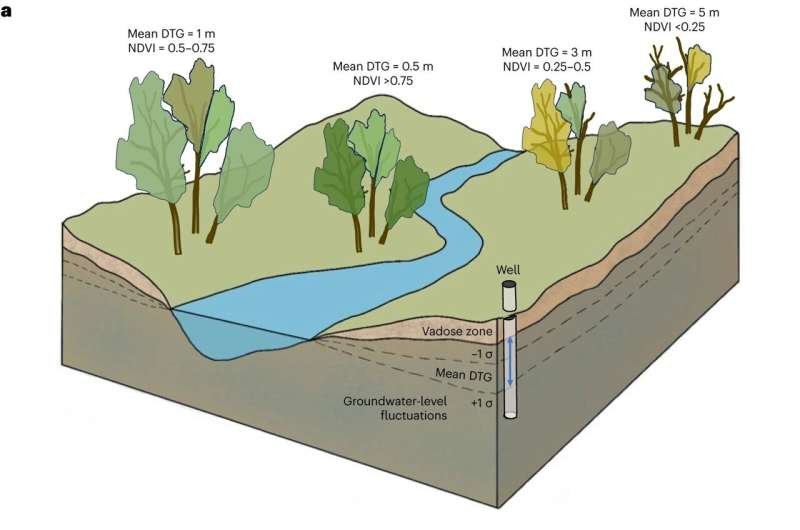This article has been reviewed according to Science X's editorial process and policies. Editors have highlighted the following attributes while ensuring the content's credibility:
fact-checked
peer-reviewed publication
trusted source
proofread
Examining groundwater's role in ecosystem sustainability

Until now, groundwater—a critical water resource around the globe, especially in dry regions—has been largely unstudied in its importance and role in sustaining ecosystems. A new research effort led by the SUNY College of Environmental Science and Forestry (ESF) in partnership with University of California Santa Barbara (UCSB), Cardiff University, and Desert Research Institute (DRI) examines the relationship between groundwater and ecosystems across California.
Their findings are featured in Nature Water.
Led by Dr. Melissa Rohde, who completed the study as part of her doctoral research in Dr. John Stella's Riparian Echohydrology Lab at ESF, the team used satellite imagery and groundwater monitoring data to identify thresholds of groundwater depth and seasonal change that can support sensitive ecosystems throughout California under the state's Sustainable Groundwater Management Act framework.
"A vast majority of our planet's freshwater is groundwater, but we don't acknowledge or manage it sustainably, resulting in serious consequences for humans and natural ecosystems," said Dr. Rohde, now Principal at Rohde Environmental Consulting, LLC.
"Groundwater is critical for many ecosystems, but water agencies and conservationists rarely account for their water requirements. To reconcile that, our study provides a simple and practical approach to detect ecological thresholds and targets that practitioners can use to allocate and manage water resources."
Utilizing 38 years of Landsat satellite images (1985–2022) and statewide groundwater well data, the study examined impacts on key plant communities. A major challenge was to develop standardized metrics that can be applied across diverse ecosystems with site-specific water conditions.
The team applied a common data transformation method in a new way to identify thresholds of vegetation greenness and groundwater depth over time that can determine groundwater needs for ecosystems, helping to inform decisions about water use and planning.
"Groundwater-dependent ecosystems such as wetlands, floodplains, and riparian zones have very outsized importance on biodiversity. Upwards of 80 to 90 percent of species in a general region may be dependent on these ecosystems in some form or another," said Dr. Stella, study co-author and Vice President for Research at ESF.
"We applied a simple statistical approach to very large data sets to identify warning signs and conservation targets for a great diversity of ecosystem types."
The vast geographic scope and long timeline covered by the study allowed the team to evaluate how large-scale systems respond to major climate shocks, such as the historical California drought that occurred from 2012–2016, as well as where individual groundwater-dependent ecosystems can serve as resilient drought refugia.
"This type of study, covering the entire state of California over close to forty years, has really only become possible in the past few years and shows the promise for similar studies over a much larger geographic area using the approach pioneered by Dr. Rohde," remarked co-author, Dr. Dar Roberts from UCSB.
It was discovered that during drought events, groundwater-dependent vegetation that maintains a connection to groundwater could serve as critical drought refugia for associated species, such as riparian birds or fish. However, when groundwater levels deepen beyond plants' rooting zones during drought, these safe havens can be lost.
"A key takeaway from this study is that we can use what we know about how deep the roots of different types of plants tend to be to approximate what groundwater levels are needed to maintain ecosystem health," said co-author Dr. Christine Albano from DRI. "We found that vegetation was healthier where groundwater levels were within about 1 meter of maximum root depth, as compared to where groundwater was deeper."
The research team is hopeful that their approach and findings can help inform water management decisions in California and beyond.
"This study arms groundwater managers with an intuitive, site-specific measure that can provide a data-driven foundation to guide water allocation and ecosystem restoration efforts," said co-author and professor Kelly Caylor from UCSB.
"Globally, there are increasing efforts to manage groundwater resources for multiple purposes, not only to support drinking water needs or high-value agriculture. Our work provides a sound basis on which to develop clear guidelines for how to manage groundwater to support a wide range of needs within drainage basins in California and beyond," said co-author Prof. Michael Singer from Cardiff University.
More information: Melissa M. Rohde et al, Establishing ecological thresholds and targets for groundwater management, Nature Water (2024). DOI: 10.1038/s44221-024-00221-w
Journal information: Nature Water



















